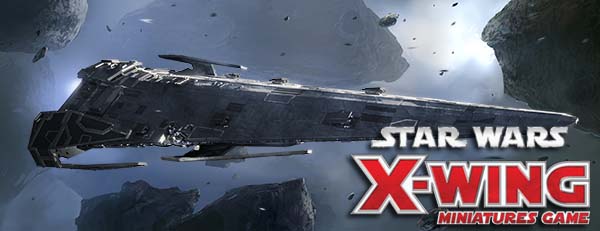
This past couple years, my girlfriend and I have been getting very into the Star Wars: X-Wing miniatures game. We've also been converting some of our friends into avid players as well. After sitting on my shelf for several years with only a couple play sessions under its belt, the set has been getting played every few weeks with regularity. As such, we've also been investing more and more into additional expansions beyond the set that I initially bought. Late in 2016, my local board game store put its Corellian Corvette expansion on sale, so I went ahead and snatched up a copy of that huge, epic expansion ship. The following year, I went on to pick up the Imperial Raider huge expansion (also on sale)..
It took a while for these two ships to get much play though (seriously, they were sitting around for years), since they don't slot into the X-Wing core rules as easily as other expansions do. Playing with the huge ships requires increasing the scale of the X-Wing game considerably. The huge ships, by themselves, cost well over 100 fleet points. As such, the basic 100-point fleets go out the window for the epic-scale matches. Instead, 300 fleet-building points are recommended if any epic ships are in play. In addition, a larger play area is needed for most epic scenarios. If you bought a play mat for X-Wing, you might need to invest in a second mat as well (and they ain't cheap).
Contents
[More]
0b70eb42-0da6-473e-8f53-83e8d72a8fd9|1|4.0
Tags:Star Wars, Star Wars: X-Wing, Fantasy Flight, board game, miniatures game, dogfighting, Corellian Corvette, Tantive IV, Imperial Raider, TIE Advance, Y-Wing, B-Wing, TIE Bomber, play mat, scenario, campaign
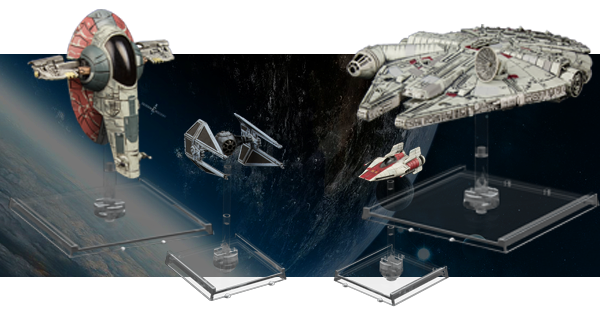
I really enjoy the Star Wars: X-Wing miniatures game, and have been playing it on and off for a few years now. Unfortunately, the core set is very lacking in variety, and so the game really needs to be expanded in order to be fully enjoyed. There's a myriad of expansions available, and they can be pricey. A single fighter ship expansion retails for $15, large ship expansions retail for $30-50, and the huge (epic) ships can cost as much as $90 or $100! If you get into this game, be prepared to spend money.
I never got into much of the Star Wars extended universe, so my interest in expansion ships has been mostly limited to content from the classic trilogy. This allowed me to be at least somewhat frugal in my early expansion purchases, but I still tried to find as much variety as I could. At the time of this review, I own (and have played with) the following expansion: Millennium Falcon, Slave I, Lambda Shuttle, VT-49 Decimator, X-Wing, A-Wing, TIE Fighter, TIE Advance, TIE Interceptor.
I also recently purchased the Corellian Corvette expansion (the foot-long huge ship that stands on two bases), but I've yet to have a chance to play it. I'm also interested in trying out the Imperial Raider, which (as I understand) is a ship that was conceived for the X-Wing miniatures game and then also ported into Armada. I also haven't played the "Most Wanted" expansion, which adds a third faction and could hypothetically allow for three-player games. I don't think that there's an official ruleset for a three-player deathmatch though, so even with a third faction, you'd probably just be playing in teams.
Small ships (fighters)
There's really not much to be said about the small fighter expansions, as they play (mostly) the same as the X-Wings and TIE Fighters that come packaged with the core set. Each ship comes with its own special abilities that add some nuanced differences to how they play, but they still play similarly at fundamental levels.
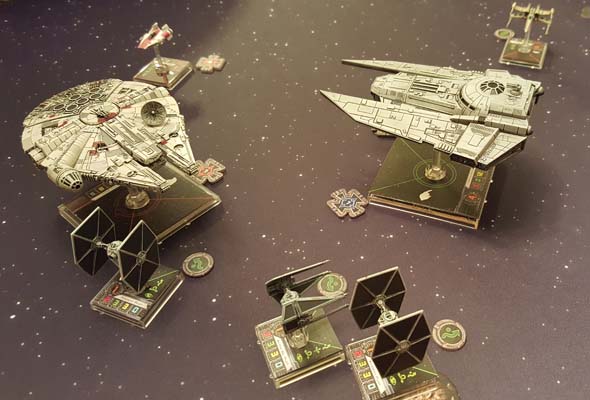
Be very aware of each ship's Pilot Skill, as the risk of collisions dramatically increases with more ships.
The biggest change (and most obvious ones) is that they allow for larger fleet sizes, which complicates the board and requires more careful management of your ships. With more ships in play, you have to be much more aware of what ships are where, what their respective pilot skills are (e.g. their turn order), and what kind of movements and abilities each possesses. Collisions become much more frequent and harder to avoid as more ships are added, and a careless player will probably also find themself running their own ships into each other -- especially if you're trying to fly tightly-packed formations. Of course, I've never run my own ships into each other ...
Perhaps the most obvious expansion is stand-alone X-Wings and TIE Fighters. These are a little bit more than a simple repackaging of the core game's components... [More]
335e38fd-7d74-43a5-be9f-9b9da0b74b65|0|.0
Tags:Star Wars, Star Wars: X-Wing, Fantasy Flight, board game, expansion, miniatures game, dogfighting, Millennium Falcon, Han Solo, Chewbacca, Lando Calrissian, YT-1300, Slave I, Boba Fett, Lambda Shuttle, VT-49 Decimator, X-Wing, Wedge Antilles, A-Wing, TIE Fighter, TIE Advanced, Darth Vader, TIE Interceptor, weapon arc, dice
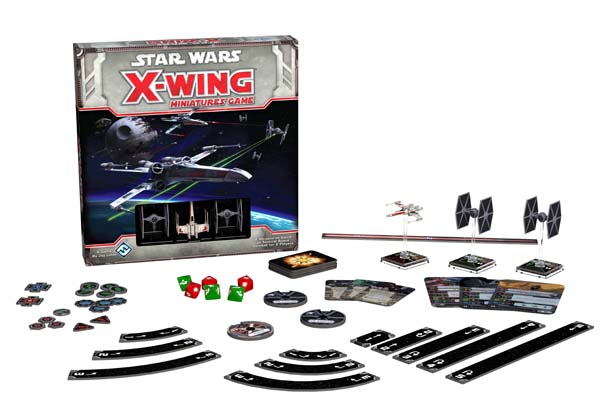
There's two versions of this game available now. The original one was released back in 2012 and was based on the original Star Wars trilogy. With the release of The Force Awakens in 2015, Fantasy Flight released a variant core set based on the new movie. The variant set includes miniatures based on the new Resistance X-Wings and First Order TIE Fighters, as well as some revised rules.
I haven't played the variant set with the revised rules, so this review will focus on the original release of the game. My understanding is that the rule changes in the updated version do not alter mechanics, but rather it makes some clarifications for some circumstantial edge cases. If I ever do get a chance to play the revised rules, and find that they substantially alter the game, then I'll either write a separate review of that, or I'll add to this review (depending on how extensive the changes are).
I've had this game for a few years, but didn't play much of it over that time period. Lately, however, my girlfriend and I have gotten really into it -- trying to play a game every weekend or two -- and have been buying lots of expansion ships. So I decided that it was time for me to finally get around to reviewing the game.
Miniature games are a dangerous thing to get into. The core set for X-Wing contains only three ships: a single X-Wing and two TIE Fighters. Without expansions, this leaves the game with relatively little replay value, as there's only so much you can do with such a small roster of ships. There's a handful of pre-made mission scenarios and character cards that can add a bit more variety. The ships themselves are very high quality models - nearly collectible-quality models. Screw having a box, when you're not playing the game, you can display these miniatures on a shelf or in a curio cabinet somewhere! Other components in the set have good production value, which is one of the trademarks of Fantasy Flight games.
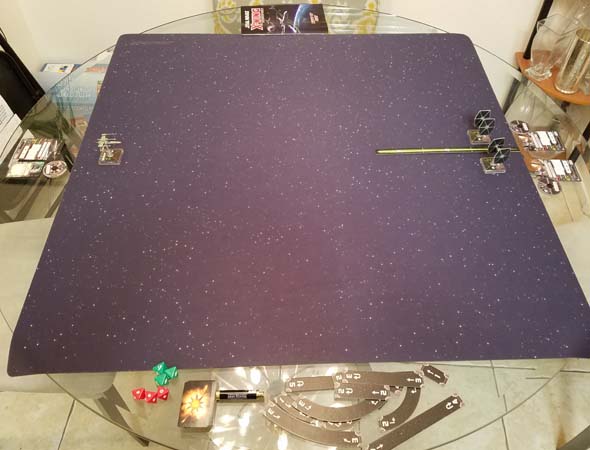
The game has no board, but is played on any 3'x3' playing surface. Fantasy Flight does sell optional play mats.
Since this is a miniatures game, there is no actual game board. Instead, you'll need a 3 foot by 3 foot playing surface for the play area, plus some extra room for ship cards and components. Fantasy Flight sells play mats with various patterns, along with numerous other accessories. You can also get away with a solid black sheet of 3'x3' felt or cloth from your local craft store, or a bigger sheet if you want larger play areas (you can fold a sheet of cloth to any size you need). In lieu of such a play surface, the game box includes a set of 4 cardboard "corners" that you can use to delineate the borders of the play area. The play area can also be decorated with asteroids or other cardboard obstacles that come packaged in the game.
Plastic dogfights
The game itself is a four-phase process. In the first phase (Planning Phase), each player secretly selects a maneuver for each of their ships using a cardboard dial. This maneuver will determine the ship's movement during the following phase.
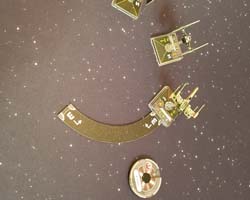
The maneuver templates make ship
movement simple and intuitive.
The second phase is the Activation Phase, in which each ship executes its planned movement. Each ship has a pilot assigned to it, which has a skill level on that pilot's card. Ships are moved ("activated") one at a time in ascending pilot order (lowest skill pilot goes first). The ship's chosen maneuver is revealed, and ship movement is handled by slotting a cardboard maneuver template into the front of the ship's base, picking up the ship, and finally slotting the back of its base at the far end of the maneuver template. In general, movement is a pretty easy mechanic to execute.
It gets a little more complicated if there's overlap between objects in the play area. In the event of a collision, the ship moves as far along its maneuver template as possible before it collides with the other ship or obstacle... [More]
facbf813-9dce-41d5-91ab-609bb8917614|0|.0
Tags:Star Wars, Star Wars: X-Wing, Fantasy Flight, board game, miniatures game, dogfighting, X-Wing, TIE Fighter, Luke Skywalker, R2-D2, weapon arc, dice, Jay Little
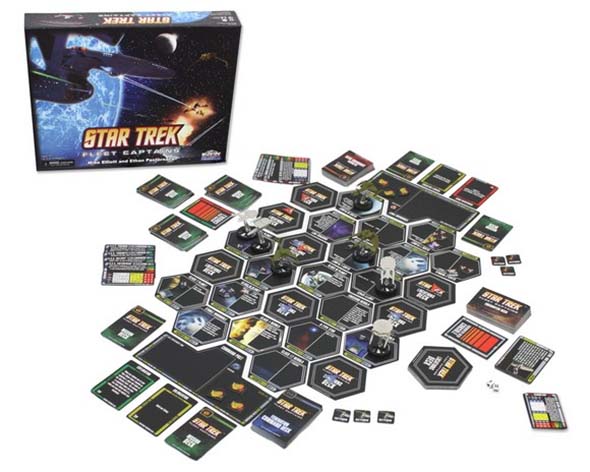
Star Trek: Fleet Captains is an exploration and combat board game by WizKids.
Good Star Trek games are few and far between. That goes for both video games and board games. Part of the reason for this is that it's often difficult to capture the spirit of Star Trek when trying to adapt it into en existing game genre. This is why Trek-themed games end up turning into dull shooters or tactical combat games. Games about exploration or scientific discovery, or role-play are sadly uncommon in video game formats (which is what makes 1999's PC game Birth of the Federation stand out to me as an underrated Trek classic). Sure it was just a reskin of Master of Orion II, and it had lots of technical and A.I. flaws, but in a market dominated by cookie-cutter games like Star Trek: Armada, Elite Force, and Invasion, Birth of the Federation was a rare game in which "exploring strange new worlds" and "seeking out new life and new civilizations" was a primary game mechanic.
Board games and table-top games have maybe fared a bit better than video game adaptations. We have our Dungeons & Dragons-inspired role playing games, our tactical starship simulators, and then countless board game reskins (ranging from Monopoly to Settlers of Catan, and virtually everything in between). Most of these games are pretty old, but there's also a handful of newer Star Trek games that run the gamut. One such game is WizKids' Star Trek: Fleet Captains.
WizKids is probably best known for its Mage Knight and Hero Clix miniatures games based on fantasy, video game, and comic book characters. The bases for these figures include a rotating dial that allows the player to change the attributes of the character to one of several pre-set values. This can include altering their combat attack power, hit points, mana, or any other value that the specific game might require. Fleet Captains uses a similar clix system as the backbone of its starship management mechanics.
Unboxing impressions
My first impressions upon opening the box was a bit disappointing. I'm not a big fan of the ship miniatures. They're fairly well-detailed and made out of a sturdy plastic and seem like they should stand up to a lot of play, but that's the only thing that I like about them. They take up a lot of space, making it difficult to cram more than two or three ships on any single hex. There seems to have been some effort made to scale the size of the Federation ships with one another, but it isn't consistent. Voyager, for example, is almost as large as the Enterprise E, but the Enterprise A and Reliant are noticeably smaller and appear decently-scaled against the Galaxy class Venture. Klingon ships, however, seem to have no effort put into trying to appropriately scale them. Birds of Prey and classic cruisers look huge compared to most Federation ships and to other Klingon ships. The Negh'var, despite being one of the largest ships in the game, just doesn't seem as massive and intimidating as it should be.
Despite the manual showing painted miniatures in its components list [LEFT],
the actual miniatures [RIGHT] are unpainted and not to-scale with one another.
The ships are also all are made of the same mono-chrome plastic and are un-painted (even though the instructions appear to show painted miniatures in the components list). These ships are different enough in design that it's really not hard to tell them apart, and so I see no reason why they couldn't have been painted (as opposed to being the same color for ease of recognition)... [More]
b4ed0de9-dad0-40a2-8fb7-fdfa4f9f20d1|2|3.0
Tags:Star Trek, Star Trek: Fleet Captains, starship, board game, miniatures game, Hero Clix, WizKids, victory points, hex, exploration, Mike Elliot, Ethan Pasternack
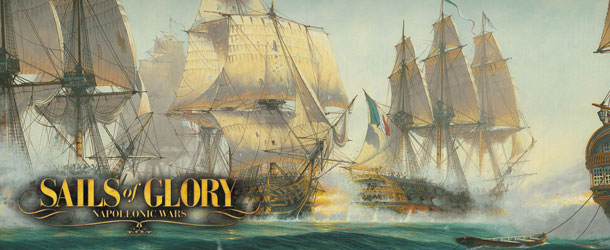
I haven't reviewed many board games. I like to play board games, and there's quite a few that I'd like to review. Sadly, it's been difficult to organize regular board game meetings over the past few years due to the ever-changing work schedules of my social circle and other adult responsibilities. Stupid jobs and chores, always getting in the way of the stuff I want to do! Most of the board games that I play only get played once or twice (and sessions are often months or years apart), which is certainly not enough play-time to justify writing a review, since it's barely enough time to get a really good feel for how the mechanics and strategies of the game work.
But one game that really piqued my interest was Sails of Glory: Napoleonic Wars, a game about naval combat in the age of sail. It is made by Ares Games, the same company that created the WWI and WWII dogfighting game Wings of Glory. If you've ever played the more popular Fantasy Flight games Star Wars: X-Wing or its sister game Star Wars: Armada (both being games that I'd like to review), then you should feel pretty comfortable with Sails of Glory. X-Wing was based off of Ares' Wings of Glory game, and both Armada and Sails of Glory use similar mechanics and rules. Sails of Glory certainly shares more in common with Armada though, since both games involve slow-paced battles between large capital ships, rather than the faster dogfighting mechanics of their predecessors. And both Sails of Glory and Armada simulate the lumbering nature of their respective ships with mechanics that require players to pre-plan their movements ahead of time, which adds a whole new element of strategy and challenge.
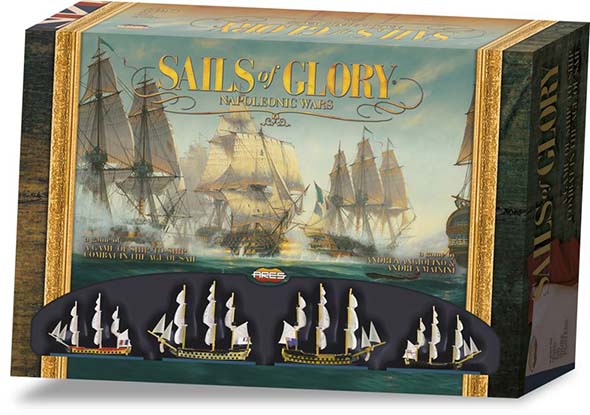
Sails of Glory includes 4 pre-assembled French and British ship miniatures.
Sails of Glory isn't a traditional board game, in that it doesn't include an actual board to play on. Instead, the game requires the players to move their ship miniatures across a playing surface (the size of which is determined by the specific scenario being played) by using a deck of maneuver cards. Movement isn't restrained to a grid of squares or hexes, so lots of careful measurement and manipulation of the models is necessary. Players must maneuver their ships in order to get the enemy ships into the firing arc of their cannons in order to attack, and the winner of the game is usually the one who destroys all the enemy ships; though, some scenarios have other winning conditions.
Another key difference between X-Wing / Armada versus Sails of Glory is that all of Sails of Glory's actions are treated as simultaneous. This helps to keep the game flowing a bit more quickly by allowing the player to move their ships and determine combat damage at the same time, rather than having to take turns moving one ship at a time. It also alters the strategy a little bit by permitting "mutual destruction". Since all ships are considered to fire at the same time, there is the possibility that ships may destroy each other in the same turn. It is only in the case of collisions (or possible collisions) that the game requires ships to be moved in a specific order. [More]
47c75ecc-1a9c-47a2-b9c1-61d80f93ff1b|0|.0
Tags:Sails of Glory, Sails of Glory: Napoleonic Wars, board game, miniatures game, Ares Games, sailing, age of sail, ship of the line, frigate, wind, maneuver, cannon, line of sight, weapon arc, chit, Andrea Angiolino, Andrea Mainini
|

| 12 | | | | | | | 60 | | 11 | | | | | | | 55 | | 10 | | | | | | | 50 | | 09 | | | | | | | 45 | | 08 | | | | | | | 40 | | 07 | | | | | | | 35 | | 06 | | | | | | | 30 | | 05 | | | | | | | 25 | | 04 | | | | | | | 20 | | 03 | | | | | | | 15 | | 02 | | | | | | | 10 | | 01 | | | | | | | 05 |
|